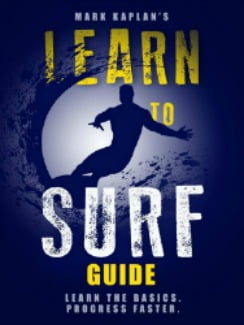4 Beginner Surfer Fundamentals
The 4 Beginner surfer fundamentals should be mastered to pave the way to advanced surfing. Surfing is more technical than people realize when they begin, but they soon learn the importance of getting everything right.
Getting on the Surf Board
This would seem to be the easiest part, but it is something most beginners struggle with. I have beginner surfers hold the surfboard to their chest as the foam wave approaches in shallow water.
When the wave is 20 feet away, they roll over so their feet are in the back and their body is in a straight line in the middle of the board. Even after beginner surfers have learned to ride waves, they have trouble catching them because they don’t get this right.
Catching Waves
Catching waves is about timing. As a foam wave and later a real wave approach, the beginner surfer paddles to get momentum. Once the wave is close on a foam wave or rolls under the board on a real wave, the surfer paddles hard.
On a foam wave, the beginner surfer has to get in front of the wave before putting hands on the board. On a real wave, the board has to start down the face. Three to four hard paddles is usually sufficient for either.
Popping Up
The beginner surfer initiates the pop up when the wave is pushing the board. The surfer puts his hands on the surf board in a man’s push up position. Then he pushes up and puts his back foot flat on the board under his butt. As he stands on the back leg, he lifts his hands and moves the front foot to the nose.
The pop up is a sequence. It is important to get each step in the right order and perform smoothly. I give students a count and tell them to count out loud for each step. This keeps them from thinking and just following the procedure.
Riding the Surfboard
The beginner surfer must be in the right stance on the board. This feet should be shoulder width apart and the front foot at a 45 degree angle facing forward, The hips and shoulders should be squared to the front and the knees flexed.
If the beginner surfer rides straight to the beach without doing any work, his body is correct on the surfboard. if the surfer falls off the butt side, he has one shoulder back instead of them being squared. If the surfer flies off the front of the board, it is because he kept his hands on the board until both feet were on the board.
Learn More
For Oceanside Surf Lessons, see the Home Page
See the Post Surf Lessons Begin with Foam Waves
See the Post What You Learn in a 2 Hour Lesson
See the Post How to Progress in Surfing
See My Dry Land and In Water Demo video
See How to Catch a Green/Real Wave video
i have lowered my book and course prices for the lock down.
My New Surfing Course in an E-Book plus Demo Video
Get the 18 Chapter, 7,500 word Course that can prepare you for a lesson or give you the fundamentals if you are going to try it on your own. 10 years of teaching 350 students a year has given me the insights on the most precise measures you must follow for success. This course is what I teach on the dry land and in water instruction. The Course includes a 15 minute video on my dry land and in water demonstration. Only $4.95
Buy the E-book for $2.99. Learn to Surf (Different cover but same book)
Buy the Paperback on Amazon $6.95
Get Learn to Surf Course in 29 minute audio. Great prep for a lesson, reviewing after a lesson, learning on your own, refreshing after not having surfed for a while. See Table of Contents. Only $7.95

80 page Learn to Surf Book
![Surf Instructions Beginner to Advanced: Learn to Ride Waves by [Kaplan, Mark]](https://images-na.ssl-images-amazon.com/images/I/51HswFtoBQL.jpg)
Buy my E-book on Amazon Kindle for $2.99. 80 pages of beginner to advanced instructions to help you before the first lesson to learning expert techniques and tricks.
I also have books on Creating Your Own Happiness on a site called Happiness and Work Life Balance